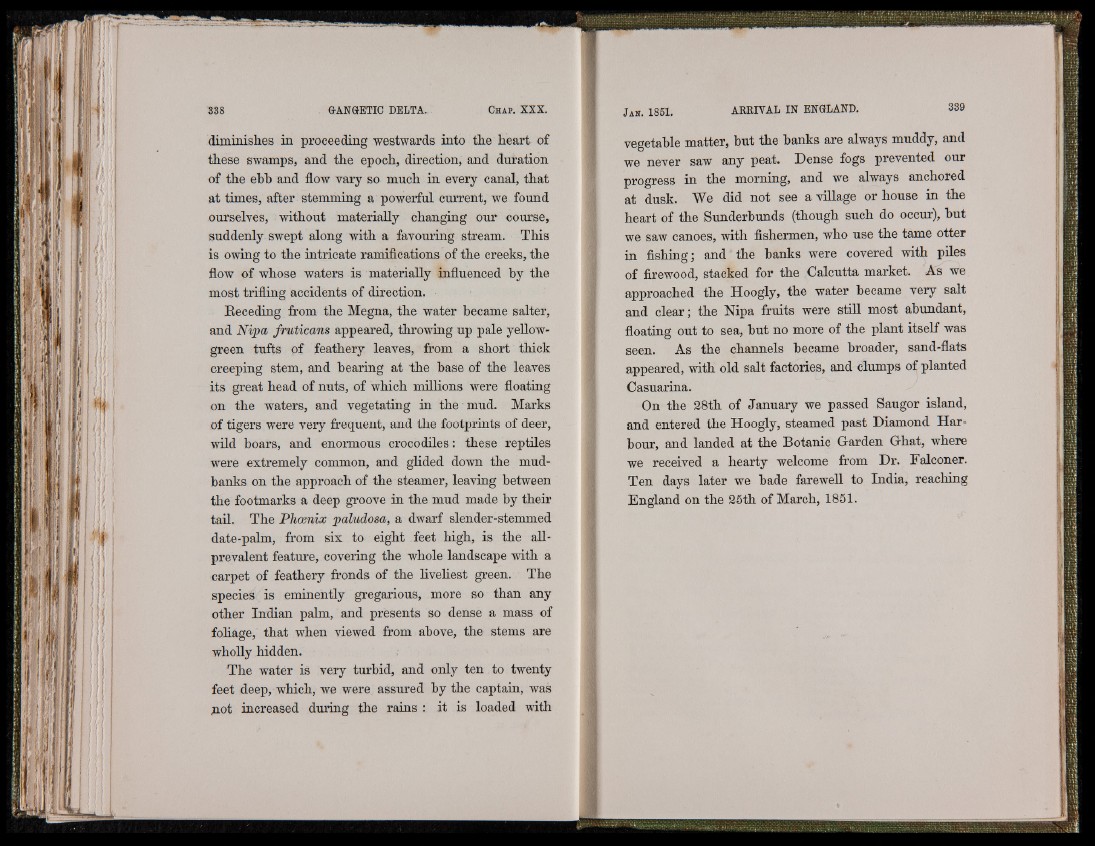
diminishes in proceeding westwards into the heart of
these swamps, and the epoch, direction, and duration
of the ebb and flow yary so much in every canal, that
at times, after stemming a powerful current, we found
ourselves, without materially changing our course,
suddenly swept along with a favouring stream. This
is owing to the intricate ramifications of the creeks, the
flow of whose waters is materially influenced by the
most trifling accidents of direction.
Receding from the Megna, the water became salter,
and Nipa fruticans appeared, throwing up pale yellow-
green tufts of feathery leaves, from a short thick
creeping stem, and bearing at the base of the leaves
its great head of nuts, of which millions were floating
on the waters, and vegetating in the mud. Marks
of tigers were very frequent, and the footprints of deer,
wild boars, and enormous crocodiles: these reptiles
were extremely common, and glided down the mud-
banks on the approach of the steamer, leaving between
the footmarks a deep groove in the mud made by their
tail. The Phoenix paludosa, a dwarf slender-stemmed
date-palm, from six to eight feet high, is the all-
prevalent feature, covering the whole landscape with a
carpet of feathery fronds of the liveliest green. The
species is eminently gregarious, more so than any
other Indian palm, and presents so dense a mass of
foliage, that when viewed from above, the stems are
wholly hidden.
The water is very turbid, and only ten to twenty
feet deep, which, we were assured by the captain, was
pot increased during the rains : it is loaded with
vegetable matter, but the banks are always muddy, and
we never saw any peat. Dense fogs prevented our
progress in the morning, and we always anchored
at dusk. We did not see a village or house in the
heart of the Sunderbunds (though such do occur), but
we saw canoes, with fishermen, who use the tame otter
in fishing; and the banks were covered with piles
of firewood, stacked for the Calcutta market. As we
approached the Hoogly, the water became very salt
and clear; the Nipa fruits were still most abundant,
floating out to sea, but no more of the plant itself was
seen. As the channels became broader, sand-flats
appeared, with old salt factories, and clumps of planted
Casuarina.
On the 28th of January we passed Saugor island,
and entered the Hoogly, steamed past Diamond H a rbour,
and landed at the Botanic Garden Ghat, where
we received a hearty welcome from Dr. Falconer.
Ten days later we bade farewell to India, reaching
England on the 25th of March, 1851.